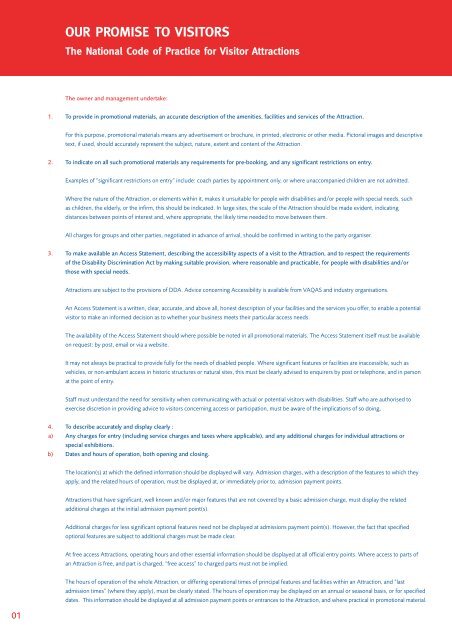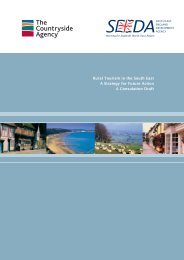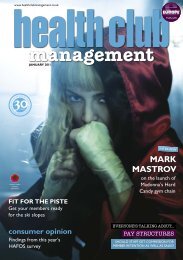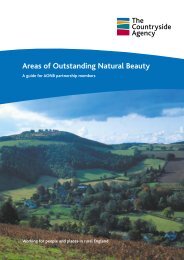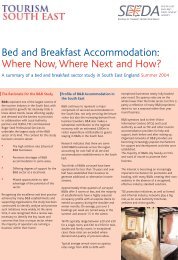National Code of Practice for Visitor Attractions - thedms
National Code of Practice for Visitor Attractions - thedms
National Code of Practice for Visitor Attractions - thedms
You also want an ePaper? Increase the reach of your titles
YUMPU automatically turns print PDFs into web optimized ePapers that Google loves.
OUR PROMISE TO VISITORS<br />
The <strong>National</strong> <strong>Code</strong> <strong>of</strong> <strong>Practice</strong> <strong>for</strong> <strong>Visitor</strong> <strong>Attractions</strong><br />
The owner and management undertake:<br />
1.<br />
To provide in promotional materials, an accurate description <strong>of</strong> the amenities, facilities and services <strong>of</strong> the Attraction.<br />
For this purpose, promotional materials means any advertisement or brochure, in printed, electronic or other media. Pictorial images and descriptive<br />
text, if used, should accurately represent the subject, nature, extent and content <strong>of</strong> the Attraction.<br />
2.<br />
To indicate on all such promotional materials any requirements <strong>for</strong> pre-booking, and any significant restrictions on entry.<br />
Examples <strong>of</strong> “significant restrictions on entry” include: coach parties by appointment only, or where unaccompanied children are not admitted.<br />
Where the nature <strong>of</strong> the Attraction, or elements within it, makes it unsuitable <strong>for</strong> people with disabilities and/or people with special needs, such<br />
as children, the elderly, or the infirm, this should be indicated. In large sites, the scale <strong>of</strong> the Attraction should be made evident, indicating<br />
distances between points <strong>of</strong> interest and, where appropriate, the likely time needed to move between them.<br />
All charges <strong>for</strong> groups and other parties, negotiated in advance <strong>of</strong> arrival, should be confirmed in writing to the party organiser.<br />
3.<br />
To make available an Access Statement, describing the accessibility aspects <strong>of</strong> a visit to the Attraction, and to respect the requirements<br />
<strong>of</strong> the Disability Discrimination Act by making suitable provision, where reasonable and practicable, <strong>for</strong> people with disabilities and/or<br />
those with special needs.<br />
<strong>Attractions</strong> are subject to the provisions <strong>of</strong> DDA. Advice concerning Accessibility is available from VAQAS and industry organisations.<br />
An Access Statement is a written, clear, accurate, and above all, honest description <strong>of</strong> your facilities and the services you <strong>of</strong>fer, to enable a potential<br />
visitor to make an in<strong>for</strong>med decision as to whether your business meets their particular access needs.<br />
The availability <strong>of</strong> the Access Statement should where possible be noted in all promotional materials. The Access Statement itself must be available<br />
on request: by post, email or via a website.<br />
It may not always be practical to provide fully <strong>for</strong> the needs <strong>of</strong> disabled people. Where significant features or facilities are inaccessible, such as<br />
vehicles, or non-ambulant access in historic structures or natural sites, this must be clearly advised to enquirers by post or telephone, and in person<br />
at the point <strong>of</strong> entry.<br />
Staff must understand the need <strong>for</strong> sensitivity when communicating with actual or potential visitors with disabilities. Staff who are authorised to<br />
exercise discretion in providing advice to visitors concerning access or participation, must be aware <strong>of</strong> the implications <strong>of</strong> so doing.<br />
4.<br />
a)<br />
b)<br />
To describe accurately and display clearly :<br />
Any charges <strong>for</strong> entry (including service charges and taxes where applicable), and any additional charges <strong>for</strong> individual attractions or<br />
special exhibitions.<br />
Dates and hours <strong>of</strong> operation, both opening and closing.<br />
The location(s) at which the defined in<strong>for</strong>mation should be displayed will vary. Admission charges, with a description <strong>of</strong> the features to which they<br />
apply, and the related hours <strong>of</strong> operation, must be displayed at, or immediately prior to, admission payment points.<br />
<strong>Attractions</strong> that have significant, well known and/or major features that are not covered by a basic admission charge, must display the related<br />
additional charges at the initial admission payment point(s).<br />
Additional charges <strong>for</strong> less significant optional features need not be displayed at admissions payment point(s). However, the fact that specified<br />
optional features are subject to additional charges must be made clear.<br />
At free access <strong>Attractions</strong>, operating hours and other essential in<strong>for</strong>mation should be displayed at all <strong>of</strong>ficial entry points. Where access to parts <strong>of</strong><br />
an Attraction is free, and part is charged, “free access” to charged parts must not be implied.<br />
The hours <strong>of</strong> operation <strong>of</strong> the whole Attraction, or differing operational times <strong>of</strong> principal features and facilities within an Attraction, and “last<br />
admission times” (where they apply), must be clearly stated. The hours <strong>of</strong> operation may be displayed on an annual or seasonal basis, or <strong>for</strong> specified<br />
dates. This in<strong>for</strong>mation should be displayed at all admission payment points or entrances to the Attraction, and where practical in promotional material.<br />
01


